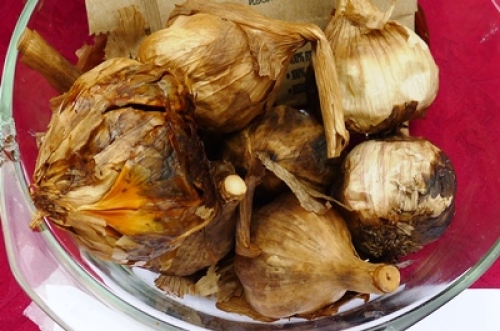
Apparently black garlic is a real thing. I didn’t believe it at first.
I saw heads of black garlic for sale at a vendor’s table during a large expo last summer and wasn’t sure what I was seeing. The garlic bulbs were still whole, but the papery coating was a dark brown and the garlic inside was black. I thought it might be a special variety of garlic, like Chesnock red.
It seems black garlic originated in Asia many years ago where it’s still considered a delicacy and enjoyed for its health benefits. Some say it has twice the amount of antioxidants as regular garlic.
Heads of fresh garlic undergo a lengthy process of cooking and caramelizing (or as some call it, fermenting) at low heat. The heat works on the amino acids and sugars inside the garlic causing cloves to turn black.
But don’t be put off by the color. The process results in a sweeter garlic with a softer texture. After the garlic’s transformation, it’s eaten on its own or added to recipes for a milder flavor over fresh garlic.
A quick online search shows black garlic available for ordering as finished bulbs, but also as a health supplement in tablets or capsules. Some stores may also carry the whole black garlic bulbs on their shelves. It seems expensive to buy in all its forms.
However, experts say vegetable gardeners can make their own. The process requires at least one piece of special equipment: either a rice cooker dedicated to the cooking or a special black garlic fermenter (also available online).
Homegrown garlic bulbs are cooked on the lowest setting or around 150 degrees Fahrenheit for around 10 days. Some say to place the cooker outside because the odor of cooking garlic can be overpowering.
After the garlic turns black, it’s cured at room temperature while it dries, then it’s stored in the refrigerator.
This homemade process is different from the authentic, naturally processed black garlic. That garlic can take up to 90 days to process.
Would you try making your own black garlic? Why or why not?


















Comments
Log in or create an account to post a comment.
Sign up Log in